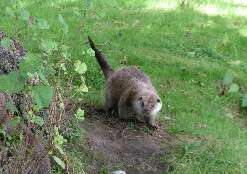(PhysOrg.com) -- The solitary and mysterious lives of British otters are being uncovered by Cardiff scientists – thanks to help from the public.
Otters were already understood to use scent as their main means of communication. However, little was known about what information was communicated or the social functions of the scent.
Part of the problem for scientists has been the elusive nature of the otter in the wild. The pioneering Cardiff University Otter Project, currently led by Dr. Elizabeth Chadwick, got round the problem by appealing to the public to send in dead otters they found. By teaming up with Dr Carsten Müller, a chemical ecologist and Eleanor Kean, postgraduate researcher, the scientists have been able to study the scent glands from more than 150 otters, making new discoveries about scent signalling.
The team at the School of Biosciences has uncovered a complex mix of 432 chemicals, including some previously thought to be absent from otter secretions. They also found marked differences in scent depending on age and gender.
The team found they could successfully distinguish between adult and juvenile otter scents. There were also differences between male and female scents in adult otters, but not in the juveniles. The discovery suggests that scent plays a role in attracting mates.
The biggest difference was between pregnant or lactating female otters and male or juvenile otters. Male otters are known to kill cubs, so mothers are likely to be very secretive. Females are reported to deposit their faeces in water, possibly to hide the differences in scent noticed by the Cardiff team.
School of Biosciences postgraduate student Eleanor Kean, who led the scent research, said: "We have been able to study the complexity and variety of otter signals in far more depth than has been possible in the past. For this, we are extremely grateful to members of the public, the UK Environment Agency, RWE npower and everyone else who has helped with the Otter Project. Our findings are a first step to better understanding of otter scent communication, which could help in the future to better monitor wild populations of the species."
Environment Agency biodiversity specialist for Yorkshire Amanda Best has high hopes for the research. She said: "It’s great news that we now know there are differences in otter scents.
"Otters are returning to our region because there are good fish stocks in our rivers. This in turn is an indicator of good water quality."
The Cardiff team’s findings have just been published in the journal Chemical Senses.
Provided by Cardiff University



















